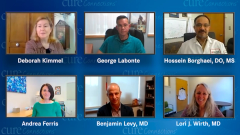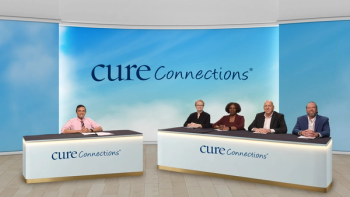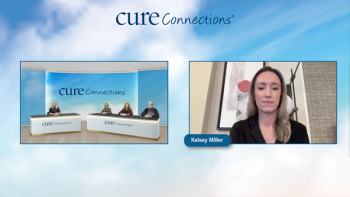
Educating Patients on Germline and Somatic Testing
Drs Benjamin Levy and Lori J Wirth describe the differences between germline and somatic mutations, explain how these are detected and used to guide treatment for lung and thyroid cancer, and comment on counseling patients about concerns of hereditary findings.
Episodes in this series

Hossein Borghaei, DO, MS: Dr Wirth, I’m going to ask you to outline, in a simplified fashion, the differences between germline mutations in a way that you would explain it to your patient in the clinic.
Lori Wirth, MD: This question is really relevant for people with medullary thyroid cancer [MTC], where about 25% of medullary thyroid cancers occur in the setting of a familial syndrome. Other thyroid cancers are almost never associated with a familial inherited syndrome. Other thyroid cancers are, but they’re very uncommon, whereas 25% of MTCs will occur in a familial setting. Those are the patients who harbor germline mutations. We can detect those mutations by a simple blood test, and what we’re doing is detecting a mutation in the RET gene, which was inherited from one’s mother or father through the egg or the sperm and is present in every cell in the body. We send off a blood test because that RET mutation that’s germline can be detected in the blood cells as well as any other tissue that you would biopsy.
That’s done because we want to make sure we know whether our individual patient has the familial syndrome, and we care for not just that patient but also the patient’s first-degree family members—their mother, father, siblings, and children. It’s important to identify every single index case because occasionally families are identified when the first person in the family gets a diagnosis of MTC. Then the other family members can be identified and be appropriately treated.
That’s different from a somatic mutation in RET that can also cause medullary thyroid cancer, and that somatic mutation will arise in the thyroid tissue itself, inherited not from the mother or the father but just by bad luck and being a human being. A mutation will spontaneously occur in the thyroid gland, in the RET gene, and that mutation will give rise to a medullary thyroid cancer. We can test for somatic mutations in MTC tumor biopsies and identify RET mutations in the cancer itself in a large number of patients who don’t have the familial syndrome.
Hossein Borghaei, DO, MS: What are some of the more common questions you get from your patients after you’ve discussed the results of the molecular testing?
Lori Wirth, MD: The most common one is, “Does this mean that there’s a good drug for me?” Having a good therapeutic option is, of course, the most important thing. Fortunately, there are many patients who do have mutations that would have a gene-specific therapy available to them, and then the question is, “If there are several options, what’s the best option for this patient?” As Ms. Ferris mentioned, we often think about sequencing therapy as well because we hope our patients are going to live for a long time and maybe have more than one drug therapy in their lifetimes. The other thing that people are very worried about is if they can pass this on to their kids. It can be difficult to explain that for most of our molecular diagnostics, we’re not getting results that have anything to do with genes that can be passed on to one’s kids. Often, we forget to talk about that with patients, and often people forget to ask us to clarify that. Normally these tests don’t detect mutations that can be passed on to one’s kids.
Hossein Borghaei, DO, MS: That’s great. Ben, are these very similar to the questions that you get after discussing biomarker testing?
Benjamin Levy, MD: One of the things patients want to know, as Dr. Wirth mentioned, “Is this inherited? Do I need my kids or my family members tested?” We have a discussion about what’s a germline mutation and what’s a somatic mutation and what can we act on. We want to know about the available therapies. For some of these genes, often there are competing therapies, and there may be news out there about one therapy over the next. Patients still want to know about the role of immunotherapy.
The direct-to-consumer advertising has been very effective. It says, “Is there a role for immunotherapy down the line?” Patients in my practice want to know what the intent of therapy is. This is a very important discussion to level set what the goals of therapy are. I’m very honest with my patients, and hopefully Ms. Kimmel can attest to this. I tell them, “The drugs will not melt the tumor all the way; that’s unlikely. But the goal is to shrink this down and keep it down for a very long period of time. We’ve come a long way, and we think this drug will selectively kill your tumor cells without much collateral damage. It will improve your symptoms, your quality of life, your longevity.”
Those are things that I always talked about. One of my favorite phrases is “shared expectations.” What are the shared expectations as we start on this journey together? I try to go over those. People will think, “Targeted therapy, precision medicine.” Yes, it’s very exciting. It’s a great time to be in the field of lung cancer. Patients are fortunate enough to see therapies that we wouldn’t dream we would have. That said, we need to be mindful of what the goals are and have those shared expectations as we go through the process and the journey with the patient.
Hossein Borghaei, DO, MS: Great points as usual. Thanks. Ms. Ferris, anything to add to this discussion?
Andrea Ferris: No, it’s been very informative and terrific. I encourage everybody to get comprehensive biomarker testing if you’ve been diagnosed with non–small cell lung cancer.
This transcript has been edited for clarity.


